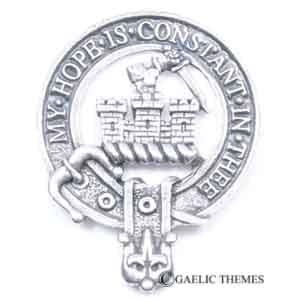MacDonald of Clanranald
Select
- Clan Motto: My Hope Is Constant In Thee
- Notes:
Crest: A triple-towered castle Argent masoned Sable, and issuing from the centre tower a dexter arm in armour embowed grasping a sword all Proper.
Ranald was the son of John of Islay, Lord of the Isles, who had married Amy Macruari, heiress to the vast lordship of Garmoran.
Ranald was the second and the eldest surviving son of John and Amy. As such, he was heir to the chiefship of Clan Donald. However Ranald did not inherit. The title went instead to his younger half-brother, Donald whose mother was the daughter of Robert II and thus a Stewart princess. There seems to have been no tension surrounding this arrangement. Ranald even took part in Donald’s installation at Eigg. Ranald did get a strong inheritance via a charter his father had arranged with Robert II in 1273 which entitled him to lands in Moydart, Arisaig and Lochaber. Ranald had five sons. His eldest, Alan, succeed to the chiefship of Clanranald. His other son Donald founded the line of Glengarry.
In 1419, Alan died at the family castle seat of Tioram. His son, Roderick, succeeded him and was a staunch supporter of the Lord of the Isles. Roderick, in turn, passed away in 1481 and was succeeded by his eldest son, Alan.
Alan was a respected war chief. His noted accomplishment being a raid into Badenoch in 1491 which resulted in the capture of Inverness Castle. Even as the Clan Donald star fell after their attempted revolt, Clanranald weathered the storm. Alan Macruari was one of the few highland chiefs to pay homage to King James IV.
The seventh chief, Alexander, ruled in peace and raised a large family, marrying three times. Interestingly, his chosen heir was an illegitimate son -- John Moidartach. It seems that of all Alexander’s sons, John was deemed the most capable to physically lead the clan in battle. John was pronounced legitimate by an Act of the Privy Council in 1531. He would go on to lead Clanranald through dangerous times.
Upon coming to the throne, James V annulled any charters granted while he had been a minor. Many highland chiefs rebelled, including the various Donalds. James led a force to the Isles and John of Clanranald was arrested along with other chiefs. While John was imprisoned, another descendant of Alan Macruari, Ranald Gallda, laid claim to Castle Tioram and occupied it.
Upon James V’s death 1542, Mary, Queen of Scots’ regent, the Earl of Arran, released all of the Island chiefs. John was free to take his revenge on Gallda. Their forces met at Loch Lochy in 1544 at the battle of Blar-na-leine, and Ranald was killed. John would finally be acknowledged as chief of Clanranald in 1584.
Clanranald were loyal supporters of both Charles I, and later, the Stuart Pretenders. Chief Clanranald was integral to Montrose’s victory at Inverlochy in 1645. His son, Donald, also fought with Montrose at Kilsyth, leading a brilliant charge against enemy infantry.
In 1686, the fourteenth chief, Alan, succeeded Donald at the age of just thirteen. Three years later, he led his clan to fight for James VII but was forced to flee to France. In 1715, Alan again rallied for the Jacobite cause and was rewarded with the title of Lord. He was killed leading his forces at Sheriffmuir in November of 1715. He was succeeded in French exile by his brother Ranald.
Ranald’s son, Donald of Benbecula, was next. His son, another Ranald, became famous in the 1745 Rising as “Old Clanranald” while his dashing son, Ranald, became ‘Young Clanranald”.
After Culloden, Young Clanranald escaped to France but returned in 1754. His descendants held the leadership until finally dying out in 1944. The chiefship, or captaincy, passed to heirs of Alexander Macdonald of Boisdale. In 1956, Ranald Alexander Macdonald, captain of the clan, was recognized as Chief by Lord Lyon.
